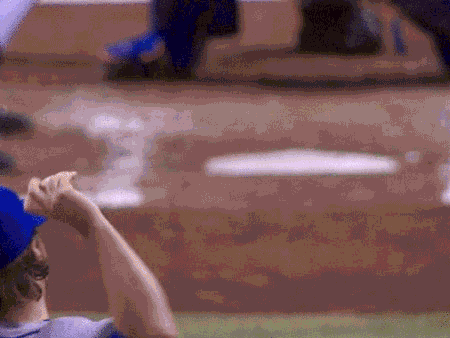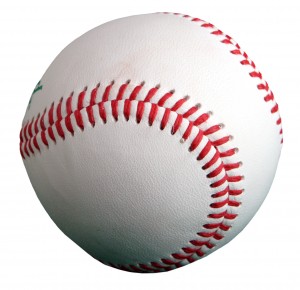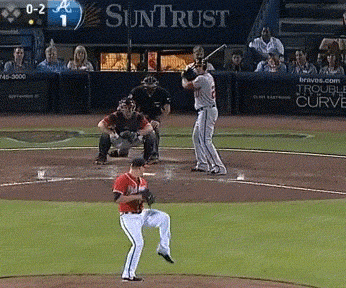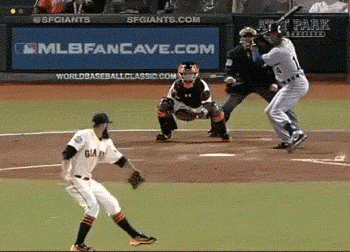I love baseball. You would have to ask my mom why I love baseball so much, but it started when I was 6-ish and hasn’t really let up. Some baseball fans love it for the statistics, and you might think that the geeky numbers part is what attracted me. Well, I honestly don’t watch as much baseball as I would like and have mostly followed baseball through box scores and statistics, but I really think I enjoy baseball mostly for watching it.
Let me make things even more confusing. If you go to a baseball game with me, you will likely end up listening to me joke about how boring it is to watch, and how ridiculous the rules are. I also won’t get too excited about big comebacks or my team winning. These things are all nice, but they aren’t the most exciting parts about baseball.
The best part of baseball is the amazing skills the players have honed. It turns out some baseball players are quite out of shape but still effective because they have particularly quick reflexes or can swing a bat well. The topic of this post, however, is going to be pitching, which I will explain in words and GIFs as best as I can having never pitched in my life.
Quick rules recap: the pitcher throws the ball to the catcher crouched behind home plate (a white pentagon). There’s a batter, who is trying to hit the ball with the bat. If the ball is thrown over the plate roughly between the batter’s knees and the middle of the batter’s torso, it’s a “strike”. If it’s too high, too low, or too far left or right, it’s a “ball”. If the pitcher throws 4 balls, then the batter gets to go to first base automatically. If the pitcher throws 3 strikes, then the batter is out, and the next batter comes up. Additionally, if a batter swings and misses at a pitch (whether it’s in the “strike zone” or not), then it counts as a strike. If the batter hits the ball, then it’s in play, where the rest of the defense must try to get the batter out.
The pitcher’s goal is to get the batter out. Hopefully, they can make the batter swing and miss until they strike out, but they at least want the batter to swing poorly and induce a weakly hit ball that the defense can easily handle. There are 3 primary ways that pitchers try to trick batters:
- Throw it so hard that the batter can’t react quickly enough. These pitches are called fastballs and can go as fast as 100 miles per hour (mph). To see how fast these pitches are, try out this reaction time test from the Exploratorium. This is the primary pitch type used.
- Throw it slowly to confuse the batter and make them swing too early. This is most effective when players try to get into the groove of the speed of fastballs. These are called changeups and can go 10+ mph slower than a fastball without any noticeable change in a pitcher’s windup.
- Throw it with a lot of spin so that the ball isn’t where the batter is swinging. These are called breaking balls and can make batters look silly as they swing wildly in the wrong place.
So let me break down the most common pitches in baseball. I’ll explain briefly how the pitch is gripped and thrown, what the pitch does, and what it looks like (in a GIF). For reference, here’s what a baseball looks like:
Fastballs
4-seam fastball. This is the standard way to throw a baseball around (pitching or not). You curl your ring and pinky fingers under and hold the ball with your thumb, index finger, and middle finger. For a 4-seam fastball, the index and ring fingers will each cross the red seams of the ball twice (2 x 2 = 4 seams). The pitch doesn’t move much, but you can throw it really hard. Because of the Magnus effect, the ball may even appear to rise slightly. A great example of a 4-seam fastball comes from Craig Kimbrel, the young closer for the Atlanta Braves.
Cutter or cut-fastball (2-5 mph slower than 4-seam fastball). The cutter is somewhere between a fastball and a slider. This is admittedly nebulous, but the effect is a hard-thrown pitcher that moves slightly right-to-left very late. For a right-handed pitcher throwing to a left-handed batter, this is devastating as the batter will slightly over-swing and hit the ball on the thinner part of the bat close to their hands. This often results in broken bats and induces a lot of weakly hit balls. My favorite pitcher, Roy Halladay, has an effective cutter, but the king of the cutter is Mariano Rivera of the New York Yankees. He has several minor variations on this pitch, and they’re all impossible to hit. Sorry for the crappy gif, but you can watch Sports Science for a more in-depth explanation.
2-seam fastball (1-2 mph slower than a 4-seam fastball). The 2-seam fastball is just freaky. The ball is gripped with the index and middle finger along the seams at the narrowest point, and by applying pressure to the ball with different fingers, you can make the ball spin off-center. The freaky part is that the ball basically goes the wrong way. A right-handed pitcher brings his arm from his right across his body to the left, so you would expect pitches to move right to left. Well, the 2-seam fastball moves down and to the right. This pitch is just hard to follow. Check out this pitch from Matt Moore of the Tampa Bay Rays (note that he’s left-handed, so everything I said is flipped around.
Sinker (about as fast as a 4-seam). The sinker is similar to the 2-seam fastball and is gripped roughly the same way. The difference is that the main emphasis is on making the ball sink. Even if the batter still hits the ball, they will likely hit it weakly so it dribbles along on the ground for an easy defensive play. Check out the sinker from Johnny Venters. Not impressed with the movement? Note that he threw it at 95 mph, which is harder than most major league pitchers can throw any of their pitches. For more Venters, check out this post.
Splitter or split-finger fastball (7 mph slower). To throw a splitter, wedge the ball between your index and middle fingers. When done correctly, the pitch will look like a fastball, then suddenly drop at the end of the pitch, like a more extreme sinker. It’s kind of a changeup too, but whatever. Here’s Freddy Garcia of the New York Yankees throwing a splitter:
Breaking Balls
Curveball (15 mph slower). The curveball is almost synonymous with breaking balls, and despite what it sounds like, most of the curve is just the ball dropping. The ball is held with the index and middle fingers together and opposite the thumb, so your fingers form a backwards “C” (if you’re right-handed). When you throw it, your arm is coming down and you let go with your thumb first, so the ball gets a lot of top-spin on it. Hopefully, it looks like it’s going into the strike zone, but then it drops down to the ground and the batter just misses. There are many great curveballs out there, but my favorite is from Adam Wainwright of the St. Louis Cardinals.

Slider (7-9 mph slower). The slider is gripped like a curveball but is thrown harder, so it’s kind of in-between a curveball and a fastball. By changing exactly where it comes off your fingers, however, you can make the ball move differently (primarily making it move laterally from right to left). This can make batters “chase” a ball as it moves away from them. Like curveballs, there are many sliders out there, but here’s one from Sergio Romo of the San Francisco Giants.
Changeup
Changeup (10 mph slower). There are a ton of different grips you can use for changeups, so I’ll defer to wikipedia for the variants. The basic grip is just to grab the ball with your entire hand and throw. When done correctly, the arm action will be identical to the fastball, so a player won’t realize it’s a changeup until they swing way too early. It’s a little hard to see how tricky a changeup is, but here’s one from Cole Hamels of the Philadelphia Phillies. Also, here’s a post on Chase Anderson’s changeup.

Knuckleball
Knuckleball (60-70 mph, so maybe 20-30 mph slower?). I said there were 3 basic types of pitches, and I didn’t lie, despite adding this 4th type. The knuckleball is the joker of all pitches, and it is the riskiest. Essentially, the ball is gripped with your fingertips, and you kind of “push” the ball with your fingers towards the batter. The goal is to reduce the spin to almost nothing (less than a single turn on a good day). When that happens, the ball will move according to the turbulence over the seams and the weather. Literally.
The effect is that the ball will wobble and move in just about any direction, making it difficult to catch and even more difficult to hit. Sometimes. If there’s too much spin on the ball, or if you just don’t get the right turbulence, the ball will go flat, and since the pitch is usually thrown somewhat slowly, it will be an easy pitch for a batter to hit a home run.
Only a few pitchers in history have really mastered the knuckleball, but we happen to have probably one of the greatest pitching today: R.A. Dickey of my Toronto Blue Jays. Check. This. Out.

Oh, here’s another one. And GoPro footage from the perspective of the catcher.
Conclusion
There are lots of other strange pitches out there, but this covers most of them. To wrap up, imagine yourself as a batter: you know exactly what pitches the pitcher can throw (scouts compile binders with these details), and you basically need to guess what pitch the pitcher is going to throw and where they’re going to throw it. You can watch their arm action and guess what’s coming, but you have milliseconds to decide to swing or not. Naturally this leads to all sorts of crazy mind games.
The greatest part of baseball to me is the battle between a pitcher and batter as they try to figure each other out. The pitcher may make the ball go fast (4-seam), slow (changeup), left (slider), right (2-seam), or anywhere in in-between, and the batter has to adjust instantly to make solid contact with a wooden club. That’s why I prefer watching baseball on TV over watching it live: you can see the details of pitching, which I think is the core of baseball and best demonstrates how amazingly talented these players are.







4 replies on “GIFs of Baseball Pitches (or Why I Love Baseball)”
The “2-seam fastball” in the gif had more movement than the “sinker” in the other gif
I’ve just read an article on fangraphs site. Porcello, Hernandez, Price and many other pitchers says, the 2 seam fastball is totally same as the sinker. On the other hand, the piching coaches says, the 2 seamers don’t necessarily sinking….
I think that’s Freddie Garcia of the NY Yankees, not Baltimore Orioles on the split finger fastball gif.
You’re right! That clip is of Garcia with the Yankees. I’ll update that. Thanks!